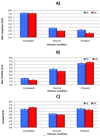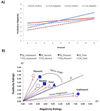THE POSITIVITY OFFSET THEORY OF ANHEDONIA IN SCHIZOPHRENIA
- PMID: 28497008
- PMCID: PMC5421554
- DOI: 10.1177/2167702616674989
THE POSITIVITY OFFSET THEORY OF ANHEDONIA IN SCHIZOPHRENIA
Abstract
Prior studies have concluded that schizophrenia patients are not anhedonic because they do not report reduced experience of positive emotion to pleasant stimuli. The current study challenged this view by applying quantitative methods validated in the Evaluative Space Model of emotional experience to test the hypothesis that schizophrenia patients evidence a reduction in the normative "positivity offset" (i.e., the tendency to experience higher levels of positive than negative emotional output when stimulus input is absent or weak). Participants included 76 schizophrenia patients and 60 healthy controls who completed an emotional experience task that required reporting the level of positive emotion, negative emotion, and arousal to photographs. Results indicated that although schizophrenia patients evidenced intact capacity to experience positive emotion at high levels of stimulus input, they displayed a diminished positivity offset. Reductions in the positivity offset may underlie volitional disturbance, limiting approach behaviors toward novel stimuli in neutral environments.
Keywords: Affective Ambivalence; Anhedonia; Emotion; Psychosis.
Figures


Similar articles
-
The positivity offset theory of anhedonia in schizophrenia: evidence for a deficit in daily life using digital phenotyping.Psychol Med. 2023 Oct;53(14):6491-6499. doi: 10.1017/S0033291722003774. Epub 2023 Feb 1. Psychol Med. 2023. PMID: 36722014 Free PMC article.
-
Digital phenotyping evidence for the reduced positivity offset as a mechanism underlying anhedonia among individuals at clinical high-risk for psychosis.Schizophr Res. 2025 Jul;281:45-51. doi: 10.1016/j.schres.2025.04.029. Epub 2025 May 2. Schizophr Res. 2025. PMID: 40318309
-
In support of Bleuler: objective evidence for increased affective ambivalence in schizophrenia based upon evocative testing.Schizophr Res. 2009 Feb;107(2-3):223-31. doi: 10.1016/j.schres.2008.09.020. Epub 2008 Oct 22. Schizophr Res. 2009. PMID: 18947981
-
Emotional Experience of People With Schizophrenia and People at Risk for Psychosis: A Meta-Analysis.JAMA Psychiatry. 2024 Jan 1;81(1):57-66. doi: 10.1001/jamapsychiatry.2023.3589. JAMA Psychiatry. 2024. PMID: 37755868 Free PMC article.
-
Anhedonia in schizophrenia: a review of assessment strategies.Schizophr Bull. 2006 Apr;32(2):259-73. doi: 10.1093/schbul/sbj009. Epub 2005 Oct 12. Schizophr Bull. 2006. PMID: 16221997 Free PMC article. Review.
Cited by
-
The cognitive, affective motivational and clinical longitudinal determinants of apathy in schizophrenia.Eur Arch Psychiatry Clin Neurosci. 2019 Dec;269(8):911-920. doi: 10.1007/s00406-018-0907-1. Epub 2018 Jun 8. Eur Arch Psychiatry Clin Neurosci. 2019. PMID: 29948250
-
The positivity offset theory of anhedonia in schizophrenia: evidence for a deficit in daily life using digital phenotyping.Psychol Med. 2023 Oct;53(14):6491-6499. doi: 10.1017/S0033291722003774. Epub 2023 Feb 1. Psychol Med. 2023. PMID: 36722014 Free PMC article.
-
Psychological Dimensions Relevant to Motivation and Pleasure in Schizophrenia.Front Behav Neurosci. 2022 Mar 23;16:827260. doi: 10.3389/fnbeh.2022.827260. eCollection 2022. Front Behav Neurosci. 2022. PMID: 35401135 Free PMC article. Review.
-
Trait Anhedonia in Schizophrenia: A Systematic Review and Comparative Meta-analysis.Schizophr Bull. 2022 Mar 1;48(2):335-346. doi: 10.1093/schbul/sbab136. Schizophr Bull. 2022. PMID: 34891171 Free PMC article.
-
Deconstructing emotion regulation in schizophrenia: the nature and consequences of abnormalities at the identification stage.Eur Arch Psychiatry Clin Neurosci. 2022 Sep;272(6):1061-1071. doi: 10.1007/s00406-021-01350-z. Epub 2021 Oct 30. Eur Arch Psychiatry Clin Neurosci. 2022. PMID: 34716486
References
-
- American Psychiatric Association. Diagnostic and statistical manual of mental disorders. Washington, DC: Author; 2000. 4, text revised ed.
-
- Bleuler E. Dementia Praecox or the group of Schizophrenias. 1950 - PubMed
-
- Boucher J, Osgood CE. The pollyanna hypothesis. Journal of Verbal Learning & Verbal Behavior. 1969;8:1–8.
Grants and funding
LinkOut - more resources
Full Text Sources
Other Literature Sources
Medical
